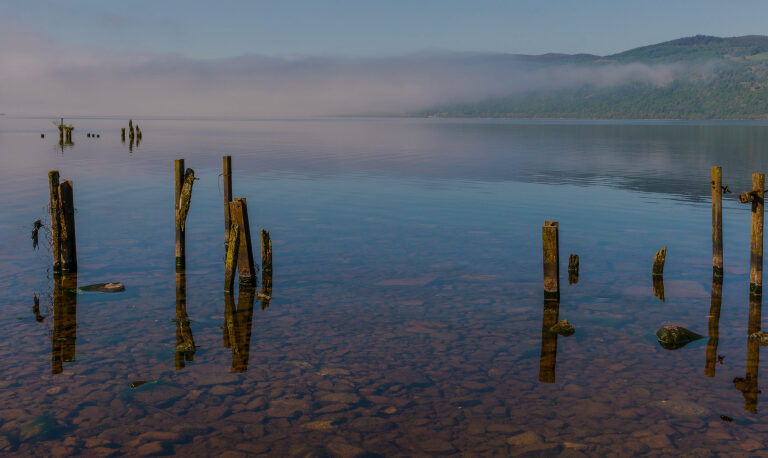The Secret Corner of the NC500: 10 Reasons to Slow Down
If you’re planning to drive the legendary North Coast 500 this year, the unassuming 120-mile stretch of road between Inverness and John o’ Groats might not seem very adventurous. After all, Google Maps predicts you will get there in less than 3 hours. Will an overnight stop even be necessary?
From ancient Pictish sculptures to historic coastal towns with fairytale castles and jaw-dropping views, read on to discover the 10 reasons why you should slow down and explore this secret corner of the NC500.
View this post on Instagram
Chanonry Point
Within a few miles of crossing Kessock Bridge and leaving Inverness, the narrow peninsula of the Black Isle invites you to take a small detour. Chanonry Point on the outskirts of Fortrose is one of the best places in the UK to spot bottlenose dolphins.
From the beach, you can see dolphins hunting and playing in their natural environment with views across the Moray Firth to Fort George. The turbulent waters are rich in salmon, and it’s estimated that around 200 bottlenose dolphins live here year-round.
For an unforgettable wildlife boat trip on the Moray Firth, contact award-winning Eco Ventures.
View this post on Instagram
Fyrish Monument
As you move north along the Cromarty Firth, small villages steeped in history welcome you to get off-the-beaten-track.
The most iconic landmark of the area, the spectacular Fyrish Monument resides on the outskirts of Alness and is easily reached on foot after a straightforward climb. This huge, spectacular structure was built in 1783, commissioned by Sir Hector Munro, and is inspired by his time in India.
View this post on Instagram
Black Rock Gorge
Nearby, another brilliant short walk through woodlands takes you to Black Rock Gorge, an unexpectedly narrow and dramatic gorge. A set of bridges let you walk right across the deep cleft and look straight down into the abyss – awe-inspiring!
This atmospheric gorge features in the Harry Potter and the Goblet of Fire film, but remains a hidden gem.
View this post on Instagram
The Pictish Trail
The Easter Ross Pictish Trail was created to link the best of the ancient Pictish sculptures found in the north-east of Scotland. We know very little about the Picts, but they were skilled sculptors and left an impressive heritage behind in the form of engraved stones and artworks scattered around the coastline.
Only a handful of miles from the official NC500 route, the Tarbat Peninsula is the perfect place to immerse yourself in this forgotten chapter of history.
Head to the picturesque fishing village of Portmahomack to visit Tarbat Discovery Centre. The museum boasts a world-class collection of Pictish art and has fascinating details about their life. Then continue to the communities of Hilton, Ballintore and Shandwick, home to many mysterious treasures from this bygone age.
View this post on Instagram
Seaboard Sculpture Trail
If ancient archaeology doesn’t tickle your fancy, you may still want to explore Tarbat Peninsula. With lovely little villages, a dramatic shoreline, iconic lighthouse and colonies of seabirds, it’s a place of tranquility and stunning views – and it’s home to the Seaboard Sculpture Trail.
Commissioned to celebrate the heritage of the Seaboard villages, the trail covers five works of art that reflect the history and characteristics of the area: Folklore, Fortitude, Fishing, the Four corners of the earth, and Faith.
Situated on the coastline off Balintore, the captivating ‘Mermaid of the North’ is inspired by local folklore and makes for a striking photo when the wind and waves bash against her.
Dornoch
The picturesque market town of Dornoch is bustling with interesting independent shops and great places to eat and drink.
Tucked away in the heart of town, the impressive 12th-century cathedral and haunted Highland castle overlook the historic village square, where markets have been held since Medieval times.
Dornoch is the perfect place to wander and get lost. You can enjoy endless miles of golden sandy beaches nearby, or let yourself be transported back in time at Historylinks Museum which showcases 7,000 years of the area’s turbulent history
After working up an appetite, relax in the superb Courthouse Cafe & Wine Bistro.
Dunrobin Castle & Golspie
Dunrobin Castle looks like it came straight out of a fairytale. Set against the blue backdrop of the sea, the imposing white silhouette towers above the formal landscaped gardens below. Turrets, lavish and decorative furnishings, family paintings and falconry displays complete the picture. Unsurprisingly, the secret of Dunrobin Castle is out and many make the journey to visit the most northerly of Scotland’s great houses.
However, a mile south the seaside village of Golspie is often overlooked but has a few aces up its sleeve. Golspie is an attractive village with a quaint harbour, long sandy beaches, wonderful walks and art gallery – The Golspie Gallery.
Our favourite short walk is the Big Burn Walk, which takes you up a gorge, crisscrossed by footbridges, ending with a spectacular waterfall – one not to miss!
View this post on Instagram
Dunbeath Castle Gardens
Continuing north along the coast, Dunbeath Castle is unmissable from the road – a beacon of white light amongst black cliffs and turbulent grey seas. Sitting alone on a rocky peninsula, the castle is privately-owned and the magnificent garden can be viewed by appointment only.
The walled-gardens are however said to be the finest in the Highlands, so it might be time to get organised!
View this post on Instagram
Wick
The former Viking settlement of Wick is the principal town in the far north of mainland Scotland. The historic town traces its roots back to Viking times, and its name comes from the Norse word ‘Vik’, meaning ‘bay’.
The excellent Heritage Centre tells the story of the area and contains an array of artefacts from the old fishing days when Wick was the busiest herring port in Europe.
The remarkable coastline, historic ruins of the Sinclair and Girnigoe Castles, Whaligoe Steps, Noss Head Lighthouse, as well as seabirds and puffins, make this a very special part of the world. Pack your hiking boots and go for a walk along the exposed cliffs, or, book an exhilarating trip on a speedboat with Caithness Seacoast.
View this post on Instagram
Duncansby Stacks
As you approach John O’Groats, one more adventure awaits in the far east corner of Scotland – the incredible Sea Stacks of Duncansby.
Start by heading to the lighthouse at Duncansby Head, officially the most northeasterly point on the British mainland. From here, a small path takes you past the dramatic Geo of Sclaites, before the two striking stacks come into view.
Standing at the edge of the cliffs with screaming seabirds overhead, puffins and seals below, wind and waves crashing against the shore, the knife-sharp rock formations look otherworldly, like a reminder of how the harsh elements have always shaped the incredible coastline of Scotland and will continue to do so.
View this post on Instagram
Discover the NC500 (Slowly) for Yourself
If you’re inspired to slow down and explore the hidden gems of the North Coast 500, Absolute Escapes offer award-winning self-drive holidays in Scotland.
We strongly suggest booking your self-drive holiday on the North Coast 500 as early as possible as accommodation is limited along the route, and we recommend staying for at least two nights in each overnight stop to allow you to relax, truly discover the local area, and contribute to local businesses.
Sine Birkedal Nielsen


